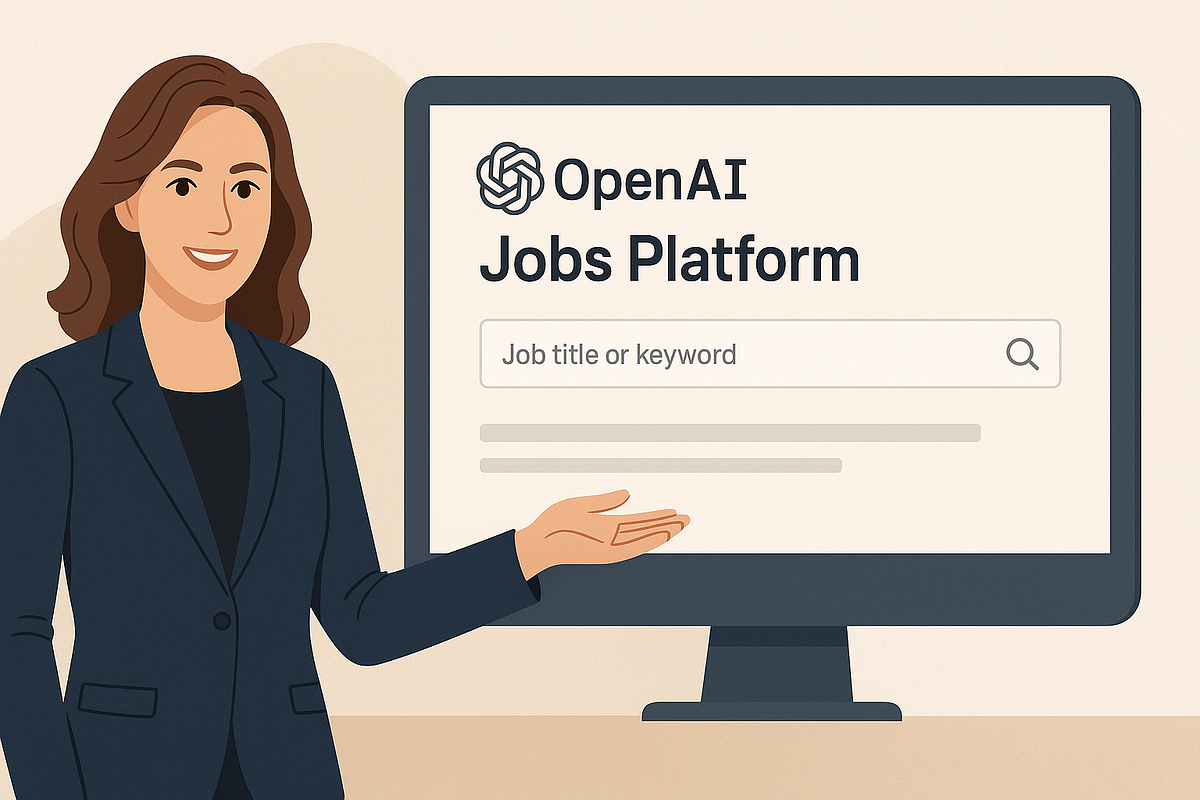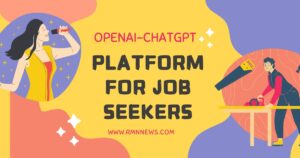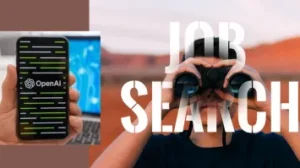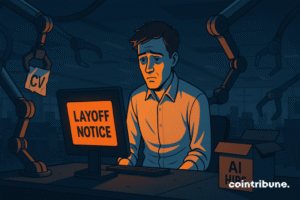OpenAI is launching an “AI-first” jobs platform — what that means (and why it matters)
OpenAI just announced it’s building an “AI-first” jobs platform — a hiring and career ecosystem that uses generative AI to help employers find talent and to help workers show and grow practical AI skills. The initiative pairs a marketplace-style jobs product with education and certification programs designed to accelerate workplace AI fluency and, according to OpenAI and multiple reporters, is slated to open to the public in the coming year with broader rollouts planned after that. OpenAITechCrunch
This is a big moment. The move positions OpenAI not just as a maker of developer tools and consumer chat experiences but as an active participant in labor markets and workforce development — a role long held by platforms such as LinkedIn. Depending on how it’s built and governed, the platform could reshape hiring practices, skills credentialing, and the balance of power between tech platforms, employers, and workers. Below I explain what OpenAI has said so far, what the product will likely look like, the immediate implications for job seekers and employers, the competitive and regulatory fallout to watch, and practical tips for anyone who wants to prepare for this next wave. TechCrunchTom’s Guide
What OpenAI announced (the essentials)
-
A jobs marketplace powered by AI: OpenAI says it’s building a Jobs Platform that will use its AI models to match employers with people who have practical AI skills and the kinds of on-the-job capabilities companies need. That includes not only developers and prompt engineers but also roles that use AI tools to augment everyday work. OpenAITechCrunch
-
Certification and training: Alongside the marketplace, OpenAI is creating training and certification pathways meant to demonstrate real-world AI competency. OpenAI leadership has publicly set ambitious targets for certification scale — the company says it aims to certify millions of U.S. workers over the next several years to speed adoption and make skills-first hiring viable. Bloomberg.comComputerworld
-
Timing and scope: Reporters cite OpenAI sources saying the jobs platform is expected to begin rolling out by mid-2026, with pilots and partnerships happening earlier. The product will target a wide range of employers, including small businesses and local governments, not just Fortune 500 firms. TechCrunchTom’s Guide
-
A different hiring philosophy: OpenAI frames the effort as skills-first and AI-literate hiring — i.e., employers should be able to evaluate practical AI capabilities rather than relying solely on degrees or résumés. That’s the conceptual shift behind the “AI-first” label. OpenAI
Why OpenAI is doing this (strategic motives)
-
Grow the addressable market for AI
OpenAI’s core business benefits when more companies and workers adopt AI tools. A jobs platform + certification pipeline accelerates that adoption, creates recurring business touchpoints, and funnels users into the company’s ecosystem (APIs, enterprise products, and apps). In short: better adoption → more product usage → more revenue and influence. -
Solve a critical friction point for companies
Many organizations report that hiring for AI-augmented roles is slow and inconsistent. A marketplace that ranks and surfaces demonstrable AI proficiency (and that uses AI itself to match people to tasks) could reduce time-to-hire and improve fit. -
Positioning and competition
This move puts OpenAI into direct competition with established professional network and hiring platforms — most notably Microsoft-owned LinkedIn — and into adjacent markets (learning platforms, workforce development). Given OpenAI’s major partnership with Microsoft, this competitive angle raises strategic tension even while the companies continue to collaborate. Barron’sTechCrunch -
Public interest and political advantage
Workforce retraining and economic displacement from automation are central political concerns. By promising large-scale certification programs and partnerships with employers and states, OpenAI can present itself as part of the solution, not just the cause of disruption. Bloomberg.com
What the product likely looks like (features to expect)
OpenAI hasn’t released the full product spec, but reporting and the company’s own hints suggest several core components:
-
AI matching engine: Beyond keyword résumés, the platform will likely analyze applicants’ real task outputs, project portfolios, and interactive assessments (for example, simulated task prompts) to rank fit between candidate and employer needs. The matching will probably be a blend of model-driven scoring and recruiter input. OpenAITechCrunch
-
Skills passports / verified assessments: Expect digital badges, micro-certifications, or verified work samples that convey concrete ability (e.g., “builds prompt pipelines,” “optimizes workflows with Copilots”). These could be issued by OpenAI’s certification program or by partner employers.
-
Learning + on-ramp programs: Bundled learning pathways and study modes (integrated into ChatGPT or standalone experiences) that prepare workers for assessments and employer needs. OpenAI has signaled ambitions to certify millions — that requires structured educational content and evaluation. Computerworld
-
SMB & government tracks: Tailored tracks for small businesses and local governments to post roles, purchase matching services, and access curated talent for AI transformation projects. OpenAI has said it plans specific support for these segments. TechCrunchTom’s Guide
-
Privacy, verification, and fraud controls: Any credible platform will need identity verification, plagiarism detection, and audit trails to ensure assessments reflect real competence.
Upsides: how workers and employers could benefit
-
Faster, skills-based discovery: For employers, AI could highlight candidates who actually know how to apply tooling and automation to business problems, rather than those who merely list buzzwords.
-
Clearer upskilling paths: For workers, tightly integrated training and certification offers a practical route to transition into higher-value roles that use AI, especially if employers come to trust those credentials.
-
Reduced hiring friction for SMBs: Smaller firms often can’t compete for top engineers. A platform that surfaces qualified, cost-effective talent and helps onboard them for AI-augmented workflows would be useful.
-
Better mobility for nontraditional talent: If certifications and task portfolios are accepted, employers may consider candidates without traditional degrees, opening doors for many workers.
Risks and concerns (what to watch closely)
-
Bias & gatekeeping: Any automated matching system can entrench biases if the training signals favor certain backgrounds or past employers. If certifications become the dominant hiring signal, access to training (costs, language, time) could create new gatekeepers.
-
Data and privacy: The platform will process sensitive applicant data and employers’ hiring criteria. How OpenAI handles data retention, consent, and model training will matter — especially because models can memorize or inadvertently expose information. Transparency and strict data controls are essential.
-
Concentration of power: A single company that owns models, certification, and a hiring marketplace could wield outsized influence on labor markets and standards. Antitrust or regulatory scrutiny may follow if the product scales quickly. Barron’s
-
Commodification of learning: If employers overvalue short badges without deep assessment, workers might chase micro-certs that look good on profiles but don’t reflect sustained competence.
-
Vendor lock-in: Employers who design hiring around a platform’s signals risk lock-in and fragility if the platform changes scoring algorithms or access policies.
The Microsoft angle: cooperation and competition
OpenAI’s platform places it in a delicate spot. Microsoft is a major investor and cloud partner for OpenAI, but it also owns LinkedIn — the dominant professional network and recruiting marketplace. Reporters have flagged the potential for friction as OpenAI builds a LinkedIn-style product while continuing to rely on Microsoft infrastructure and commercial relationships. Expect careful diplomatic choreography, and possibly parallel product moves from Microsoft (e.g., deeper AI integrations into LinkedIn) as both companies jockey for position. Barron’sTechCrunch
Policy and regulatory implications
Several regulators will watch this closely:
-
Labor regulators and unions will ask whether AI-matching respects worker protections and does not undercut fair hiring or working conditions.
-
Privacy and data protection authorities (e.g., GDPR regulators, U.S. state privacy agencies) will examine data use, profiling, and automated decision-making safeguards.
-
Education and credentialing bodies may evaluate whether OpenAI’s certifications meet accepted standards and do not mislead consumers about outcomes. OpenAI’s promise to certify millions raises questions about test design, proctoring, and verifiability. Bloomberg.com
Practical advice: how candidates, employers, and policymakers should prepare
For candidates
-
Build demonstrable work: Save artifacts — notebooks, recorded demos, portfolio projects — that showcase how you use AI to deliver outcomes, not just theoretical knowledge.
-
Learn to explain decisions: Be ready to explain your process, guardrails used, and how you evaluate model outputs — this matters for both hiring and compliance.
-
Get credentials, but vet them: Early adopter certifications can help, but prioritize credentials that require real tasks and supervised assessments.
For employers
-
Design role-based assessments: Use practical assignments that mirror on-the-job challenges rather than relying solely on platform scores.
-
Audit for bias: If you use automated matching, build human review and bias audits into your hiring pipeline.
-
Upskill current staff: Don’t only recruit externally; invest in reskilling existing employees so AI adoption doesn’t become disruptive.
For policymakers & regulators
-
Clarify standards for AI credentials: Encourage third-party evaluation of certification programs and require transparency on pass rates and equity metrics.
-
Monitor market power: Keep an eye on whether a single platform can exert undue influence on hiring markets or lock out competitors.
What success looks like — and what failure looks like
Success would mean the platform helps match millions of workers to higher-quality roles, makes hiring less biased and more skills-based, and expands economic opportunity by enabling small employers and nontraditional talent to compete.
Failure would look like a system that privileges those who can pay for training, entrenches algorithmic biases, erodes worker privacy, or becomes a bottleneck that employers and governments depend on without sufficient oversight.
Final take: a pivotal experiment in labor markets
OpenAI’s jobs platform is more than another tech product: it’s an experiment at the intersection of AI, credentials, and employment. Done well, it could accelerate useful AI adoption and expand opportunity. Done poorly, it could concentrate power, amplify bias, and turn career advancement into a transaction dominated by a single platform’s incentives.
For job seekers, employers, and policymakers, the right response is active engagement — test the product, insist on transparency, and build complementary safeguards (audits, alternative credential routes, public-sector training) so that the benefits of an “AI-first” hiring era are broadly shared. OpenAI’s announcement signals how central AI will be to the future of work — the next challenge is making that future fair, accountable, and genuinely opportunity-creating. OpenAITechCrunchBloomberg.comTom’s GuideBarron’s
Sources and further reading
-
OpenAI — “Expanding economic opportunity with AI” (company announcement). OpenAI
-
TechCrunch — coverage of OpenAI’s Jobs Platform and timeline. TechCrunch
-
Bloomberg — reporting on the Jobs Platform and certification program. Bloomberg.com
-
Tom’s Guide — summary of Sam Altman and company remarks. Tom’s Guide
-
Barron’s — analysis of how OpenAI’s moves intersect with Microsoft and LinkedIn. Barron’s
https://bitsofall.com/https-yourwebsite-com-edge-ai-hardware-powering-intelligence-at-the-edge/
Google Search AI Mode: Redefining the Future of Online Search







